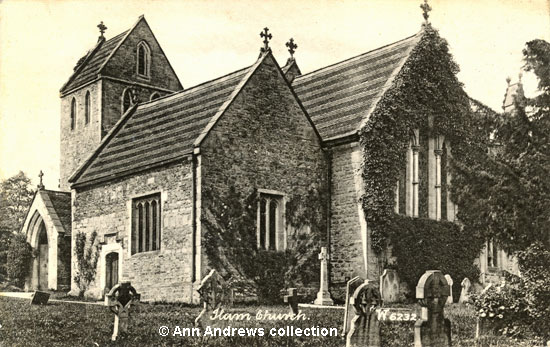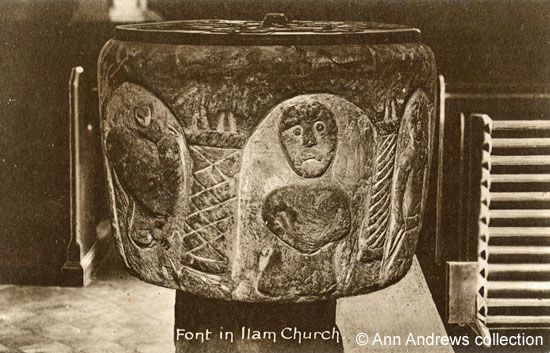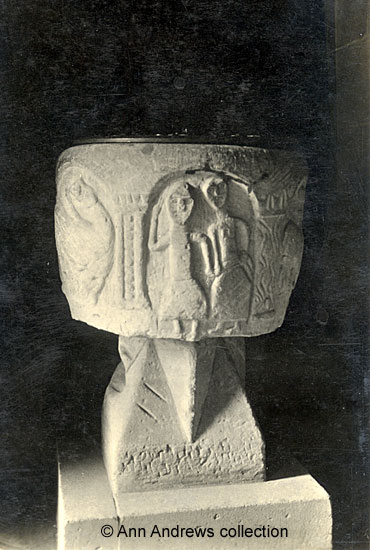Ilam is a small village in the Manifold valley, not far from the Derbyshire border and close to Thorpe Cloud and the entrance
to Dovedale. The river goes underground at Wetton and re-appears four miles away close to llam Hall. Apparently Dr. Johnson,
who was said to be a frequent visitor to the first Hall here[1a] "in his usual masterful
way, refused to believe that the Manifold disappeared underground"[1].
Sometimes there is water along the length of the river, but when it is drier it disappears.
Ebenezer Rhodes had visited Ilam in the autumn of 1820, not long before the old hall was knocked down. He was on an excursion
to Dovedale and noted that "Workmen were excavating a vault on the north side [of the church], where a spacious Gothic chapel
... was to be erected". This chapel is on the left of the top image and its architecture is markedly different from the rest of the church.
His description of how the church looked at the beginning of the 1820s is interesting. "The tower appears to
be a structure of foliage, for the stone work is so invested with ivy as to be almost entirely obscured with its verdant
covering; and the dial of the clock is half buried amongst thickly entwined leaves. Ash, elder, and wild roses, of the
most luxuriant growth and colour, flourish close around the walls of the church, and the adjoining burial ground is covered
with the richest verdure, amongst which a grey stone occasionally appears, inscribed to the memory of those who sleep beneath.
No fence or lawn marks this sequestered spot : towards the house it is open to the lawn, or only separated from it by
an invisible fence ..."[2a]
Jesse Russell had purchased the Ilam Hall estate and the advowson of the church for his son Jesse Watts Russell in 1809,
after the death of Sir John Port[p2]. Port's son, the Reverend Bernard Port, M.A.
was the vicar here is 1851 and lived in the Vicarage. He had been the incumbent since 1801. He was also the rector of Honily[k1].
When he died on 30 January 1854, he had been the vicar for more than half a century[p1].
The stone built church, which is close to the Hall, is in the Early English style and was restored by Sir Gilbert Scott R. A.
in 1856[2b]. When the church was re-consecrated a Derbyshire newspaper commented
that "the most material addition has been a new aisle on the north side, capable of accommodating 50 worshippers.
The rest of the church has, however, been so much altered that no part of it would probably be recognised, save the venerable
old porch, by those who knew it in its former condition"[3].
Scott raised the rooves and re-tiled them. He also raised the western tower and added what is known as a saddleback roof;
the roof was topped with a ridge and has two sloping sides, so the structure underneath has two gable ends - hence the
term saddle backed. The trefoiled opening below the roof is for the belfry. There is another on the far side of the tower.

View of the south porch and the 1855/6 east window.
Note that the ivy described by Rhodes had regrown.
The sender wrote "I think this is such a lovely looking old church". |
The octagonal chapel, was to house an imposing Chantrey monument in memory of David Pike Watts, whose son in law owned the
Ilam estate[2a]. A hundred years later Thomas Tudor thought Chantrey's technique
was a tour de force but was less impressed by the life size figures[5].
Watts is shown on his death bed, with his arm resting on a pillow and holding a bible in one hand. He is blessing his
only daughter (Mary Watts Russell) and her three children with his other hand[6].
Tudor may not have liked it but many others describe it as a gem of monumental art.
There are also early seventeenth century tombs to the Meverell family of Throwley Hall, including an altar tomb to Robert ob. 1626
and his wife Elizabeth ob. 1628. Their daughter Elizabeth, who married Thomas, 4th Lord Cromwell, is commemorated alongside four
small figures of her childen; she is kneeling but the memorial is undated. Memorials to the Ports, former lords of the manor, can also be found inside
the church[2b].
A shrine to St. Bertram is in the south chancel aisle. A great slab covers the saints remains, with a shrine and altar
tomb of later date. St. Bertram, was described in a academic paper on The Legend of St. Bertram that was read at a meeting of
the Manchester Literary Club as "one of the most dim and legendary of all English saints"[stb].
By "dim" it was meant that he was little known! It was suggested that he probably lived in the latter part of the 7th century.
But he evidently had a connection with Ilam Church.
The Ancient Font

The font has a circular bowl with figures carved on its sides.
xx.

"Saxon " Font, Ilam Church |
|
Opinion on the font's age is divided. Some believe it is Saxon. The Manchester group mentioned the font "on which
are sculpted certain figures said to represent the central incident in the legend".[stb].
And in 1914 a Derby paper noted that "It is quite plausible that the carvings on the font in Ilam church are intended to represent
his elopement [with an Irish Princess], misfortuned, repentance, and deliverence from sin. Other authorities, however, consider the subjects
are purely allegorical[ddt14]."
The two figures carved on the side of the font (see left) are thought to be Christ and Adam coming out of hell, but could equally be
depictions of St. Bertram and his wife; they are holding hands. On its left is a mythical beast, perhaps a dragon, and there seems to be
a human head in its mouth. |
Many people have visited Ilam and it shurch over the centuries as its setting within the Ilam Hall's park is delightful - an idyllic spot. The village
was on the tourist route for visitors to Matlock Bath, for example, who would hire a wagonette and later a charabanc to travel here on their way to Dovedale.
The web mistress first came here as fourteen year old schoolgirl, picnicking on the grass outside the church fence one sunny summer afternoon.
Also see, elsewhere on this web site:
 "The Panorama of Matlock",
pp20-30. Scroll down to the section on Dovedale. "The Panorama of Matlock",
pp20-30. Scroll down to the section on Dovedale.
 The Gentleman's Magazine Library - The Peak, see p.48 The Gentleman's Magazine Library - The Peak, see p.48
A recommended external link is to
 Wishful Thinking's
"The Holy Cross Church, Ilam" which mentions a blocked up Saxon doorway. Wishful Thinking's
"The Holy Cross Church, Ilam" which mentions a blocked up Saxon doorway.
|
References:
[1a] "Ashbourne Telegraph", 2 November 1934. Famous Bridge, Woodlands and Park Land.
[1] Firth, J. B. (1908) "Highways and Byways in Derbyshire" MacMillan & Co., London.
[2a] Rhodes, Ebenezer (1824) "Peak Scenery" pub. London, Longman, Hurst, Rees, Orme,
Brown, and Green, Paternoster Row.
[k1] "Kelly's Directory of Staffordshire", 1851.
[p2] "English Cronicle and Whitehall Evening Post", 18 August 1807. John Port had died at Calwich on 9 August 1807.
[p1] "Morning Herald", 3 February, 1854. He had been born at Ilam and was unmarried (1851 census, HO107/2146 f475 p1 s3).
The Churches Database records him as having gained in M.A. from "Brazen Nose" College, Oxford in 1801.
[2b] "Kelly's Directory of Staffordshire", 1896 and 1912.
[stb] "Manchester City News", 17 Dec 1904, Literary Club : George Gissing.
[3] "Derbyshire Advertiser and Journal", 26 September 1856.
[5] Tudor, Thomas Linthwaite (1926) "The High Peak to Sherwood, The hills and dales of old
Mercia", pub. London by Robert Scott.
[6] "Exmouth Journal", 16 May 1903.
[dd2] "Derby Daily Telegraph", 4 Jul 1914. Town and Country Gossip. |